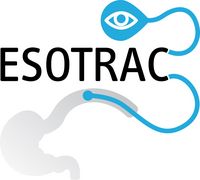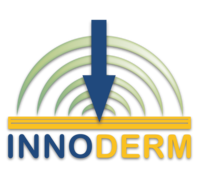ESCEND
Detection of early esophageal cancer by near-infrared fluorescence molecular endoscopy
(1 October 2018 – 30 September 2021)
ESCEND funded by national agencies (BMBF, KWF, GSRT) guided under the EU Transcan call in Horizon 2020 aims to shift the paradigm in EC early diagnosis and enhance current endoscopic performance by adding highly sensitive and quantitative fluorescence molecular endoscopy (FME) in real time. Based on exciting preliminary data using fluorescent agents targeting dysplasia and neoplasia and approved for experimental clinical use, ESCEND will advance evidence on minimally invasive FME, which is on the verge of clinical translation and with immense clinical impact and commercialization potential. FME promises to detect disease earlier, with higher specificity and sensitivity, and stratify disease in terms of cancer progression over the current state of the art. Thus, a central ambition of ESCEND is that a hybrid white-light and fluorescence endoscope will become the new BE diagnostic standard.
Website: https://www.escend.eu
ESOTRAC
Hybrid optical and optoacoustic endoscope for esophageal tracking
(1 January 2017 - 31 December 2021)
More than 450.000 people are diagnosed with esophageal cancer (EC) each year worldwide and ~400.000 die annually from the disease. ESOTRAC, a EU Horizon 2020 research program bringing together engineers and physicians, aims to significantly improve the detection of early-stage esophageal cancer. The interdisciplinary, 5-country research team develops an innovative endoscope that combines sensing of pathophysiological tissue signatures resolved by multi-spectral optoacoustic (photoacoustic) tomography (MSOT) with morphological disease signatures provided by optical coherence tomography (OCT). The resulting system will operate in label free mode and, due to its tomographic ability, visualize sub-surface tissue features, providing superior information of the esophageal wall compared to conventional video endoscopes. This comprehensive sub-surface information is expected to detect early-stage EC and enable disease staging, neither of which can be done reliably today.
Website: https://www.esotrac2020.eu
INNODERM
Innovative Dermatology Healthcare based on Label-Free Spectral Optoacoustic Mesoscopy
(01 March 2016 – 31 August 2021)
INNODERM is a 5-year research and innovation program funded by the EU under H2020. It brings together an international research team from four European countries with the aim to develop a novel raster-scanning optoacoustic mesoscopy device (RSOM) for earlier, non-invasive skin cancer diagnosis. The portable, handheld, scalable, label-free will be used for point-of care dermatology suites for fast diagnosis and skin disease monitoring. Being insensitive to photon scattering, the multispectral optoacoustic tomography device will bring a revolution to bio-optical imaging by dramatically improving upon conventional bio-optic barriers and will subsequently go beyond the abilities of current optical or optoacoustic devices. To achieve the goals of the INNODERM project, the partners will utilize cutting-edge methods in optoacoustic, photonic, and ultrasound technologies.
Website: http://www.innoderm2020.eu
OPTOMICS
Combining optoacoustic imaging phenotypes and multi-omics to advance diabetes healthcare
(01 January 2021 – 31 December 2025)
OPTOMICS is a 5-year research project funded by the EU under Horizon 2020 FET (Future and Emerging Technologies) program. The project brings together experts across disciplines from biology and multi–omics to biotechnology from five European countries with the aim to develop and validate a digital-twin model, which will generate non-invasive and inexpensive prognostic treatment and planning methods for type-2 diabetes patients. The OPTOMICS digital twin model aims to improve prediction and early detection of individuals likely to develop the disease by combining known molecular biomarkers with a novel non-invasive imaging phenotyping technology called Raster Scan Optoacoustic Mesoscopy (RSOM). To achieve these goals the OPTOMICS consortium will harness Artificial Intelligence and statistical methods combined with state-of-the-art multi-omics (genomics, metabolomics, and proteomics) and optoacoustic imaging technologies.
Website: https://optomics.munichimaging.eu
RSENSE
Revolutionizing disease and environmental detection with portable optoacoustic sensing
(01 January 2020 – 31 December 2024)
RSENSE is a 5-year research and innovation program funded by the EU under H2020. It brings together engineers and physicians from four European countries aiming for a new and innovative, disruptive technology of spectral portable optoacoustics (sPROPT). This sensor will be accessible, inexpensive, portable and non-invasive. On the one hand, sPROPT will enable frequent monitoring for early signs of diseases, such as prevalent cardiovascular and metabolic diseases. On the other hand, sPROPT will revolutionize environmental sensing by allowing sensitive, disseminated, in-vehicle measurements and monitoring for on-board diagnosis. To achieve these ambitious goals, the RSENSE consortium uses methods ranging from artificial intelligence and data analytics to advanced optoacoustic technology.
Website: https://rsense.helmholtz-muenchen.de/
WINTHER
Fast optoacoustic mesoscopy, using the skin as a window for therapeutic monitoring of local and systemic disease
(01 January 2020 – 31 December 2024)
WINTHER is a 5-year EU funded research project under the Horizon 2020 FET (Future and Emerging Technologies) scheme. It brings together the expertise of Small and Medium Size Enterprises (SMEs) and academic partners across four European countries in the field of optoacoustic imaging. The WINTHER project aims to build upon the already successful use of raster-scan optoacoustic mesoscopy (RSOM) in dermatological applications by developing the next generation of optoacoustic technology for achieving fast raster-scan optoacoustic mesoscopy (F-RSOM). This improved technology will enable assessment of progression and therapy in systemic diseases beyond dermatology and into cardiovascular and diabetes realms. If successful, F-RSOM will drive a paradigm shift in systemic disease monitoring and may dramatically improve healthcare diagnostic and prognostic options for patients and clinicians. To achieve these ambitions goals, the WINTHER project will utilize the latest technologies and methods in the fields of optoacoustics and ultrasound detectors, artificial intelligence, and data analytics.
Website: https://www.winther2020.eu





